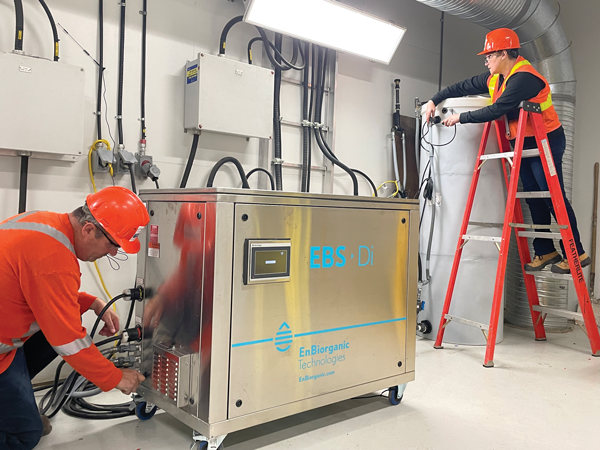Wastewater treatment plants (WWTPs) have a duty to ensure the safety and cleanliness of the effluent they process. Their responsibility goes beyond avoiding liability from contaminated water or improving bottom-line profitability. WWTP operators need to think in terms of the Triple Bottom Line: people, planet, and profits. It’s not a decision between them but a continuous, concerted effort to optimize benefits for all three.
Coined in the early 1990s by British consultant and sustainability advocate John Elkington, the Triple Bottom Line has only recently come into mainstream fashion. Almost 30 years ago, Elkington saw the need for business to emphasize their effects on people and the planet as much as their profits. Today, as we strive to make positive change amid social and climate crises, companies have embraced his wisdom in meaningful ways. But what, exactly does it mean to prioritize people, planet, and profits equally?
At the core of the Triple Bottom Line is a simple sentiment. Companies should strive to produce results that benefit people and the planet. When they do, profitability will naturally follow. Conversely, if you only focus on profit, you can’t account for the cost of doing business. This is especially true for an industry like wastewater treatment — where so much of regular operations directly affect both people and the planet.
Applying The Triple Bottom Line To Wastewater
The Triple Bottom Line ties into wastewater in many ways because it touches all three pillars of the philosophy. Unfortunately, we tend to think about profit, people, and planet in that order. The result is an industry constantly focused on remediation, reclamation, and conservation — which imply the damage is already done to the planet.
True acceptance of the Triple Bottom Line means rearranging priorities: planet, people, profits. Putting the planet first unlocks a wealth of opportunities to serve people better and increase profitability. When you spend time, energy, and investment on proactive solutions, you’re saving on the back-end — the cost differential is potentially considerable. Think about the annual cost of environmental remediation due to FOG-related buildups and the resulting damage, and it’s not difficult to see the benefit of being proactive.
Keeping Planet Central To Wastewater Treatment
Putting planet first doesn’t mean a cheap chemical fix to prevent FOG buildups. This approach actually prioritizes profit: Taking the cheapest route means putting planet second to profit. Prioritizing the planet means taking the best route.
Consider a wastewater treatment solution like the EBS-Di system from EnBiorganic Technologies. It’s an entirely organic solution. It treats wastewater the same way nature does, using microbiology. It doesn’t introduce new chemicals into the fold or rely on broad-spectrum eradication of microbes — good and bad. Instead, non-pathogenic microbiological agents are grown and trained on-site to feed off a certain diet, then released back into the wastewater environment knowing their food source. This is a true planet-first approach that serves environmental health and sustainability.
It is positioned where it can dispense these microbes into a collection system, at a level that simply overwhelms the inappropriate or problem nutrients or contaminants. It is typically placed at a lift station in the wastewater collection system at a location identified as the most advantageous location to achieve desired outcomes.
The EBS-Di does not require capital expenditure or additional operational labor/expenses by the end-user. It is provided by subscription, or through the Technology as a Service (TaaS) model. The unit is remotely controlled and monitored by the EnBiorganic technical team and serviced locally by a trained licensed service provider.
The benefits of a solution like the EBS-Di and others like it that subscribe to a natural, holistic and sustainable approach to treatment is this: they are also the best solution for people and profits! In the case of autonomous bioaugmentation technology, a well-trained pool of microbiological agents becomes more efficient than constant chemical additives, traditional bioaugmentation or other invasive means for treating effluent. The result is a more efficient — and less expensive — wastewater treatment strategy with cost savings that eventually pass on to taxpayers.
Meeting Modern Environmental Standards
Water, while one of the most abundant compounds on Earth, is quickly becoming a scarce commodity. The cost of water is rising to reflect this. Conservationists have been quick to recognize the need for better wastewater treatment practices before contaminated water reaches the environment.
Addressing water quality concerns proactively instead of through later remediation efforts fulfills the creed of the Triple Bottom Line. Prioritizing planet with an organic wastewater treatment solution furthers benefits for people and profits, and a rising tide lifts all boats. It takes commitment from municipalities to explore proactive and preventive wastewater treatment solutions — instead of a constant focus on remediation and reclamation.
As water and wastewater quality continue to be topical conversation pieces in the ongoing discussion of national infrastructure modernization, it’s essential to look toward the future with the planet, people, and profits equally in mind. And while there’s no true way to quantify the Triple Bottom Line, it’s easy to see the impact of its philosophies in action: fewer wastewater cleanup and remediation issues, improved cost savings from wastewater treatment efforts, and better water and effluent quality.
Thanks to modern solutions like the one discussed here, it’s possible to modernize wastewater treatment systems to elevate people and planet alongside profitability.

